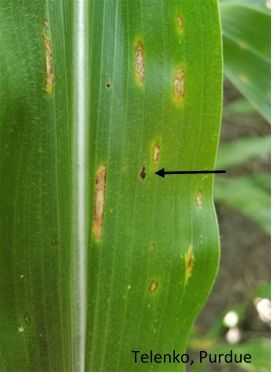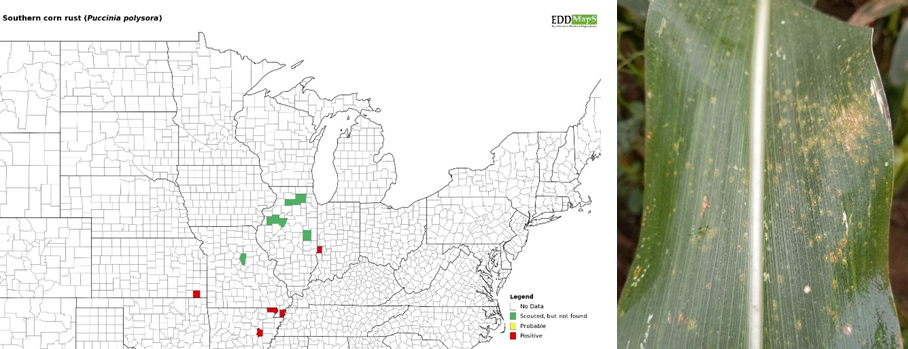Gray leaf spot is also active in the lower canopy at multiple sites across the state. The lesions are light tan in color and generally narrow and rectangular, and can be as long as 2 inches. As the lesions age they turn grey in color and are delimited by leaf veins (Fig. 1). This annual disease has become one of the most important foliar diseases in Indiana. Hybrid susceptibility and weather will have the greatest impact on the severity in a field. Fungicide options that are available for gray leaf spot would be a cost effective application in fields that have a history of disease and are planted to susceptible hybrids in no-till or reduced-till system. As a reminder, fungicide applications add an additional cost to corn production. Therefore, economic factors and other disease issues need to be considered before deciding to apply a fungicide to manage gray leaf spot. Previous research has determined the best time to apply fungicides in preventing yield loss with the most economic return occurs when fungicides are applied in response to disease at tasseling (VT) through early silking (R1).

Figure 1. Multiple gray leaf spot lesions (tan with yellow halos) found lower leaves in canopy of a field of continuous corn, surrounding a single tar spot (black arrow). (Photo Credit: Darcy Telenko)
Southern Rust
Corn pathologists have been tracking the movement of southern rust as it has been active in the south the last few weeks. We just received a positive confirmation of southern rust in Vigo County, Indiana (Figure 2). The field where it was found had very light symptoms, but we need to keep a close eye. If you suspect field has southern rust, please send a sample to the PPDL for positive identification or contact myself or your local extension.

Figure 2. Map of southern rust of corn as of 7/16/2019. EDDMapS https://corn.ipmpipe.org/
Common and southern rusts do not overwinter in Indiana. Each year the rust spores (urediniospores) travel on air currents from tropical regions to fields in Indiana. Short periods of leaf wetness are required for infection by both rust fungi. Morning dews in Indiana can provide the six hours of moisture required for infection and disease development. Generally, southern rust prefers warmer temperatures — with infection occurring between 77-82°F. Southern rust is usually detected in Indiana late August and September and generally not something to worry about. Now that we have found it mid-July and much of our corn crop is at least a month behind, it is very important to keep eye out for southern rust.
Favorable weather can cause the infection to repeat in a disease cycle as short as seven days, resulting in secondary infections and new pustules. Each pustule can produce thousands of spores that can infect corn leaves and produce additional pustules. Disease intensity can reach epidemic levels very quickly as these cycles continue. The speed at which corn rust can reach damaging levels is why it is necessary to pay careful attention to the level and timing of initial disease infection in susceptible hybrids. Young leaves are more susceptible to rust infection than mature leaves. Our late-planted corn may be at greater risk for infection since the rust spores are now here in Indiana and much of our corn is still in the mid-vegetative stages. Recent weather conditions continue to favor disease development therefore I cannot stress enough how important it will be to scout your corn fields and be on the lookout.
There are no research-based thresholds for Indiana to assist in making a decision to apply a fungicide for rust. In high-value corn production, a few pustules on 50% of observed plants could prompt a fungicide application. Fungicides are usually most effective in preventing yield loss in seed corn and sweet corn production when they are applied at disease onset in a susceptible inbred or hybrid. Fungicide applications may need to be reapplied at seven- to 14-days if weather conditions remain favorable for rust development. These thresholds do not apply to fungicide use in field corn.
Several fungicides are available to help manage southern rust, tar spot, gray leaf spot, and other leaf diseases with a recommended application occurring at late vegetative stages through R1 for most of these foliar diseases. The national Corn Disease Working Group has developed a very useful fungicide efficacy table for corn diseases. It is found at https://crop-protection-network.s3.amazonaws.com/publications/cpn-2011-corn-fungicide-efficacy-for-control-of-corn-diseases.pdf
Please feel free to contact me (dtelenko@purdue.edu) or the PPDL with any major disease issues you may have this season.


